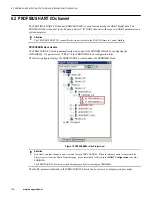
•
Device Revision Mismatch (HREVMISM)
: Used for indicating whether the existing device revision is
different from the installed device.
•
Device ID Mismatch (HDEVIDFL)
: Used for indicating whether the configured device ID is different
from the connected device ID.
•
Supported HART version (HARTVERSION)
: Used for displaying the supported HART version, like
HART 6.0 and HART 7.0.
•
Universal Command Revision (HUCMDREV)
: Used for displaying the supported HART command
revision.
•
Software Revision (HSWREV)
: Used for indicating the software revision.
•
Hardware Revision (HHWREV)
: Used for indicating the hardware revision.
•
Device Profile Code (HDEVPROFILE)
: Used for displaying the HART device profile information.
•
Private Label Distributor (HPVTLDST)
: Used for displaying the label as received in the command 0.
8.6.5 HART alarms/events processing
HART alarms/events are processed periodically in the PBHCHANNEL, which is associated with the
PBHIOMB.
There are two types of HART alarms/events that are used for monitoring the HART devices.
• Device status
• Command 48
The following operations are periodically performed for processing the HART alarms/events.
1. Check if there is a change in the DD template or HART notifications," then
a. disable all existing alarms/events
b. re-report all the existing alarms/events so that alarms/events are updated in the station with the new
strings defined in DD file or based on new HART notifications configuration.
2. Check whether the ALMENBSTATE/JOURNALONLY state is changed. The alarms/events must be enabled
or disabled based on the ALMENBSTATE/JOURNALONLY state.
3. Check whether the new alarms/events are reported from the previous scanning for both Device status and
command 48 alarm/events. If yes, then report all the new alarm/events.
Attention
If there is any PGM switch-over, then the status of all existing alarms/events is RTN and the alarms/events are
regenerated with new timestamp in the station.
Device status alarms
PBHCHANNEL supports 32 HART device status alarms (that is, 4 bytes). Each bit defines an alarm.
Byte 0 represents field device status, which is updated periodically for every HART command response data.
Byte 0 defines the following alarms.
• Bit 7: Field device malfunction alarm
• Bit 6: Configuration has changed
• Bit 5: Cold Start (device has reset/power cycled)
• Bit 4: More Status Available
• Bit 3: Loop current fixed
• Bit 2: Loop current saturated (PV out of limits)
• Bit 1: Non-primary variable out of limits
• Bit 0: Primary variable out of limits
8 PROFIBUS HART INPUT/OUTPUT MODULE (PBHIOM) FUNCTION BLOCK
204
www.honeywell.com
Summary of Contents for Experion PKS
Page 1: ...Experion PKS PROFIBUS Gateway Module User s Guide EPDOC XX88 en 431E June 2018 Release 431 ...
Page 8: ...CONTENTS 8 www honeywell com ...
Page 10: ...1 ABOUT THIS GUIDE 10 www honeywell com ...
Page 32: ...4 PROFIBUS GATEWAY MODULE PGM INSTALLATION 32 www honeywell com ...
Page 58: ...5 PROFIBUS GATEWAY MODULE PGM BLOCK 58 www honeywell com ...
Page 69: ...6 PROTOCOL BLOCK 69 ...
Page 103: ...5 Click OK 6 PROTOCOL BLOCK 103 ...
Page 110: ...6 PROTOCOL BLOCK 110 www honeywell com ...
Page 183: ...PDC Details tab Figure 6 Detail Display of PDC Details tab 7 DEVICE SUPPORT BLOCK DSB 183 ...
Page 186: ...7 DEVICE SUPPORT BLOCK DSB 186 www honeywell com ...
Page 231: ...9 PROFIBUS I O MODULE PIOMB FUNCTION BLOCK 231 ...
Page 232: ...9 PROFIBUS I O MODULE PIOMB FUNCTION BLOCK 232 www honeywell com ...
Page 236: ...10 PROFIBUS GATEWAY MODULE PGM CONFIGURATION EXAMPLE 236 www honeywell com ...
Page 264: ...13 PROFIBUS GATEWAY MODULE PGM TROUBLESHOOTING 264 www honeywell com ...
















































